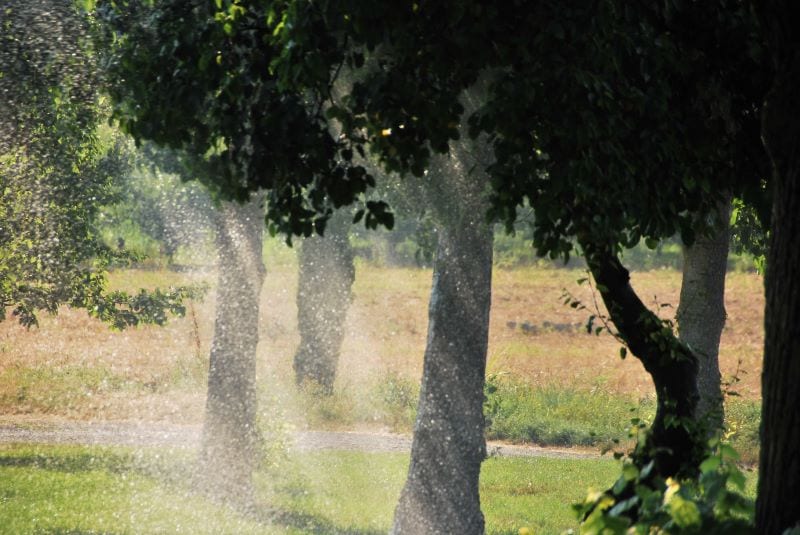Georgia pecan trees provide a series of great benefits when they are healthy. Beautiful canopies, comforting shade, and of course delicious nuts — but these benefits can be diminished if the tree isn’t healthy.
Pecan scab is a major potential issue for Georgia pecan trees.
But what is it? And how can you protect against it?
What Is Pecan Scab?
Pecan scab is a type of fungal infection that attacks various parts of the pecan tree. This includes the twigs, leaves, nuts, and shucks. It can come in the forms of lesions and lead to the death of certain tissues.
It was first described in 1882 and has seen 10 different classifications over the years — the most current being Carya illinoinensis.
This infection is spread with the help of wind and rain. The time of year generally affects the prevalence of symptoms as well as the likelihood of spreading the infection to other, previously healthy pecan trees.
Symptoms first start to appear in the early spring. And then after that, there are multiple repeating infection cycles throughout the summer. Wet conditions are necessary to provide the environment pecan scab needs to spread and grow.
Pecan scab is a major threat to pecan trees. The damage it causes can be long-lasting and severe, which makes it possibly the most economically devastating disease that can impact Georgia pecan trees.
Visit Georgia Pecan Nursery to learn more about caring for a pecan tree of your own!
Why Is It Bad?
This pathogen latches onto a host and feeds off of it. Pecan trees aren’t the only potential victim of pecan scab — walnuts and hickory nuts are another viable host — but the range of trees that can be affected by it is actually quite small.
And that is lucky for other trees because pecan scab can wreak havoc on a Georgia pecan tree. The lesions associated with the disease will continue to host it through the winter, even though the cooler temperatures are bad for it. It can also survive in leaves, twigs, and other parts of the tree.
Pecan scab can attack the leaves, leading to defoliation. Infected nuts may be reduced in size and quality. And if the infection occurs when the nut is quite young, it could kill it altogether.
Another potential outcome from pecan scab infection is the shuck — the material around the shell of the nut — clinging to the shell, making it much more difficult to harvest.
Pecan scab leads to a variety of potentially costly outcomes and can be disastrous for a pecan tree orchard.
How to Identify Pecan Scab
The most easily apparent way to identify pecan scab is by finding black spots on the leaves and the shucks of the pecan tree.
These lesions will be small, appear dark, and be found on the leaves, shucks, and twigs of the tree. It might not look like much at first — you might even just think your tree is a little dirty — but the lesions can grow larger and start to connect with each other.
The lesions will have a somewhat velvety appearance early on in their lifecycle. However, this will change as they get older. The color will become darker and the area can begin to crack or otherwise degrade.
These lesions can persist for multiple seasons with varying degrees of intensity.
How to Remove Pecan Scab
Unfortunately, you can’t. A tree that has pecan scab will have pecan scab indefinitely. However, there are measures that can be taken to manage the symptoms of the disease.
As we said earlier, the pathogen persists on the leaves and other organic material over the winter. The leaves that fall from the trees, for instance, might have pecan scab on them. And even though they aren’t on the tree, they can still contribute to spreading the disease to surrounding trees. Simply cleaning the floor around these trees and removing the debris can help mitigate the spread.
Pruning infected areas can also help this effort. Thinning out some of the trees can increase airflow which will help reduce the moist environment it needs to spread. Removing infected areas (when possible) will also help control the spread.
How to Prevent Pecan Scab
Many larger orchards will use pesticides to treat their Georgia pecan trees to prevent growth of pecan scab.
However, home growers and others that want to attempt more natural ways of addressing the issue can use some best practices to avoid the disease.
- Use pecan scab-resistant types of Georgia pecan trees
- Avoid planting your trees in low-lying areas to avoid moisture build up
- Continually clean surrounding areas of fallen leaves and other organic material


Good afternoon. I live in zone 8a and would like to order about 10 pecans 6-7ft size. What do you recommend that grows well here and is scab resistant.
I have a Stuart, Cape Fear and a few native pecans already at the location.
Additionally, how much is shipping to 27921 for said Pecans.(If you will do it) If not, do you have an Freight order departing that will drop off anywhere near me that i could go pick the order up from them? I cannot justify a trip to GA or a separate freight order for this small quantity.
Thanks.
Justin